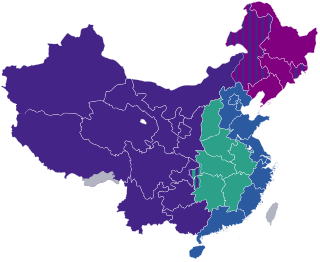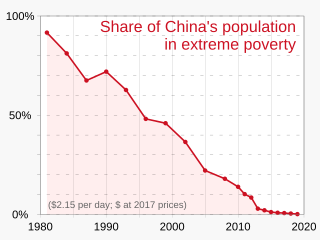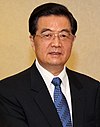
A disaster is a serious problem that happens over a period of time and causes so much harm to people, things, economies, or the environment that the affected community or society cannot handle it on its own. In theory, natural disasters are those caused by natural hazards, whereas human-made disasters are those caused by human hazards. However, in modern times, the divide between natural, human-made or human-accelerated disasters is more and more difficult to draw. In fact, all disasters can be seen as human-made, due to human failure to introduce appropriate emergency management measures.

Gross domestic product (GDP) is a monetary measure of the market value of all the final goods and services produced in a specific time period by a country or countries. GDP is more often used by the government of a single country to measure its economic health. Due to its complex and subjective nature, this measure is often revised before being considered a reliable indicator.

Chifeng is a prefecture-level city in Southeastern Inner Mongolia, People's Republic of China. It borders Xilin Gol League to the north and west, Tongliao to the northeast, Chaoyang (Liaoning) to the southeast and Chengde (Hebei) to the south. The city has a total administrative area of 90,275 square kilometres (34,855 sq mi) and as of the 2020 census, had a population of 4,035,967 inhabitants. However, 1,175,391 of those residents lived in the built-up area made of the 2 urban districts of Hongshan and Songshan, as Yuanbaoshan is not conurbated yet. However, a large part of Songshan is still rural and Yuanbaoshan is a de facto separate town 27 kilometers away from the core district of Chifeng. The city was the administrative center of the previous Ju Ud League.

China Western Development (西部大开发) is a policy adopted for the Western China.

Yangquan is a prefecture-level city in the east of Shanxi province, People's Republic of China, bordering Hebei province to the east. Situated at the eastern edge of the Loess Plateau and the west side of the Taihang Mountains, known as "Rippling Spring" in ancient times. Yangquan occupies a total area of 4,452 square kilometres (1,719 sq mi). According to the 2020 Census, Yangquan had a population of 1,318,505 inhabitants whom 1,037,456 lived in the built-up area made of 3 urban Districts plus Pingding County now being conurbated. Yangquan is a new industrial city of Shanxi province. It belongs to the warm temperate semi-humid continental monsoon climate zone. Yangquan City has jurisdiction over two counties and three districts.
Environmental policy in China is set by the National People's Congress and managed by the Ministry of Environmental Protection of the People's Republic of China. Under the Ministry of Environmental Protection of the People's Republic of China, the Department of Policies, Laws, and Regulations is in charge of establishing and strengthening basic laws and policies such as environmental laws, administrative policies and economical regulations. It is also responsible for the development of national environmental protection policy and macro strategy.
Yucheng County is a county located in the east of Henan province, People's Republic of China, affiliated to Shangqiu City, it is 47.5 kilometers wide from east to west, 67.6 kilometers long from north to south, with an area of 1485 square kilometers. It is adjacent to Liangyuan Park, Shangqiu New District and Yuyang District, bordering the provinces of Shandong to the north and Anhui to the south. It is under the administration of the prefecture-level city of Shangqiu, with a population of approximately 1.08 million and an area of 601.547 square miles (1,558.0 km2). According to preliminary statistics, in 2017, the gross domestic product (GDP) of Lucheng County was 25.72 billion yuan, the total retail sales of social consumer goods was 8.26 billion yuan, the investment in fixed assets was 23.77 billion yuan, the per capita disposable income of urban residents was 25,718 yuan, and the per capita disposable income of rural residents was 10,338. yuan

Urbanization in China increased in speed following the initiation of the reform and opening policy. By the end of 2023, China had an urbanization rate of 66.2% and is expected to reach 75-80% by 2035.

In China today, poverty refers mainly to the rural poor. Decades of economic development has reduced urban extreme poverty. According to the World Bank, more than 850 million Chinese people have been lifted out of extreme poverty; China's poverty rate fell from 88 percent in 1981 to 0.7 percent in 2015, as measured by the percentage of people living on the equivalent of US$1.90 or less per day in 2011 purchasing price parity terms, which still stands in 2022.
Taxes provide the most important revenue source for the Government of the People's Republic of China. Tax is a key component of macro-economic policy, and greatly affects China's economic and social development. With the changes made since the 1994 tax reform, China has sought to set up a streamlined tax system geared to a socialist market economy.

Beijing, alternatively romanized as Peking, is the capital of China. With about 22 million residents, Beijing is the world's most populous national capital city as well as China's second largest city after Shanghai. It is located in Northern China, and is governed as a municipality under the direct administration of the State Council with 16 urban, suburban, and rural districts. Beijing is mostly surrounded by Hebei Province with the exception of neighboring Tianjin to the southeast; together, the three divisions form the Jingjinji megalopolis and the national capital region of China.

China has an upper middle income, developing, mixed, socialist market economy incorporating industrial policies and strategic five-year plans. It is the world's second largest economy by nominal GDP, behind the United States, and the world's largest economy since 2016 when measured by purchasing power parity (PPP). Due to a volatile currency exchange rate, China's GDP as measured in dollars fluctuates sharply. China accounted for 19% of the global economy in 2022 in PPP terms, and around 18% in nominal terms in 2022. Historically, China was one of the world's foremost economic powers for most of the two millennia from the 1st until the 19th century. The economy consists of public sector enterprises, state-owned enterprises (SOEs) and mixed-ownership enterprises, as well as a large domestic private sector and openness to foreign businesses in their system. Private investment and exports are the main drivers of economic growth in China, but the Chinese government has also emphasized domestic consumption. Post-1978 economic reforms China's average GDP growth has been over 10% annually for over three decades. And in certain years, GDP growth even exceeded 13% annually. Though in recent years, their growth has significantly plummeted.

The 2008–09 Chinese economic stimulus plan was a RMB¥ 4 trillion stimulus package aiming to minimize the impact of the financial crisis of 2007–2008 on the Chinese economy. It was announced by the State Council of the People's Republic of China on 9 November 2008. The economic stimulus plan was seen as a success: While China's economic growth fell to almost 6% by the end of 2008, it had recovered to over 10% by in mid-2009. Critics of China's stimulus package have blamed it for causing a surge in Chinese debt since 2009, particularly among local governments and state-owned enterprises. The World Bank subsequently went on to recommend similar public works spending campaigns to western governments experiencing the effects of the financial crisis, but the US and EU instead decided to pursue long-term policies of quantitative easing.
The 2nd Session of the 11th National People's Congress is the annual meeting of the highest legislative body of the People's Republic of China, which was held in March 2009 at the Great Hall of the People in Beijing. The event began on March 5 and lasted until March 13. The Congress was followed closely because of the possible impact any policy changes would have on the Chinese and world economy. Major issues discussed at the Congress include the global financial crisis, industrial revitalization, curbing unemployment, and social welfare.

The economy of Beijing ranks among the most developed and prosperous cities in China. In 2013, the municipality's nominal gross domestic product (GDP) was CN¥1.95 trillion. It was about 3.43% of the country's total output, and ranked 13th among province-level administrative units. Per capita GDP, at CN¥93,213 (US$15,051) in nominal terms and Int $21,948 at purchasing power parity, was 2.2 times the national average and ranked second among province-level administrative units.
The 2014 National People's Congress held its annual meeting in March 2014 at the Great Hall of the People in Beijing, China. The session opened on 5 March and concluded on 13 March.
The national debtof the People's Republic of China is the total amount of money owed by the central government, local governments, government branches and state organizations of China. Standard & Poor's Global Ratings has stated Chinese local governments may have an additional CN¥ 40 trillion in off-balance sheet debt. Debt owed by state-owned industrial firms is another 74% of GDP according to the International Monetary Fund. The three government-owned banks owe a further 29% of GDP. China's debt level increased during the 2010s, continuing as an economic issue into the 2020s.
The Individual Income Tax in China is administered on a progressive tax system with tax rates from 3 percent to 45 percent. As of 2019, China taxes individuals who reside in the country for more than 183 days on worldwide earned income. The system is separate from the income tax system of Hong Kong and Macau, which are administered independently.

Common prosperity is a Chinese Communist Party (CCP) political slogan and stated goal to bolster social equality and economic equity. Under the leadership of CCP chairman Mao Zedong, common prosperity meant collective ownership. Paramount leader Deng Xiaoping redefined the way to achieve common prosperity by saying that some could get rich before others. Under the leadership of CCP general secretary Xi Jinping, the term gained large-scale prominence, with Xi defining common prosperity as more equal distribution of income, but also saying that it is not uniform egalitarianism.
The 11th Five-Year Plan of China, officially the 11th Five-Year Plan for Economic and Social Development of the People's Republic of China, was a set of economic goals designed to strengthen the Chinese economy between 2006 and 2010.














